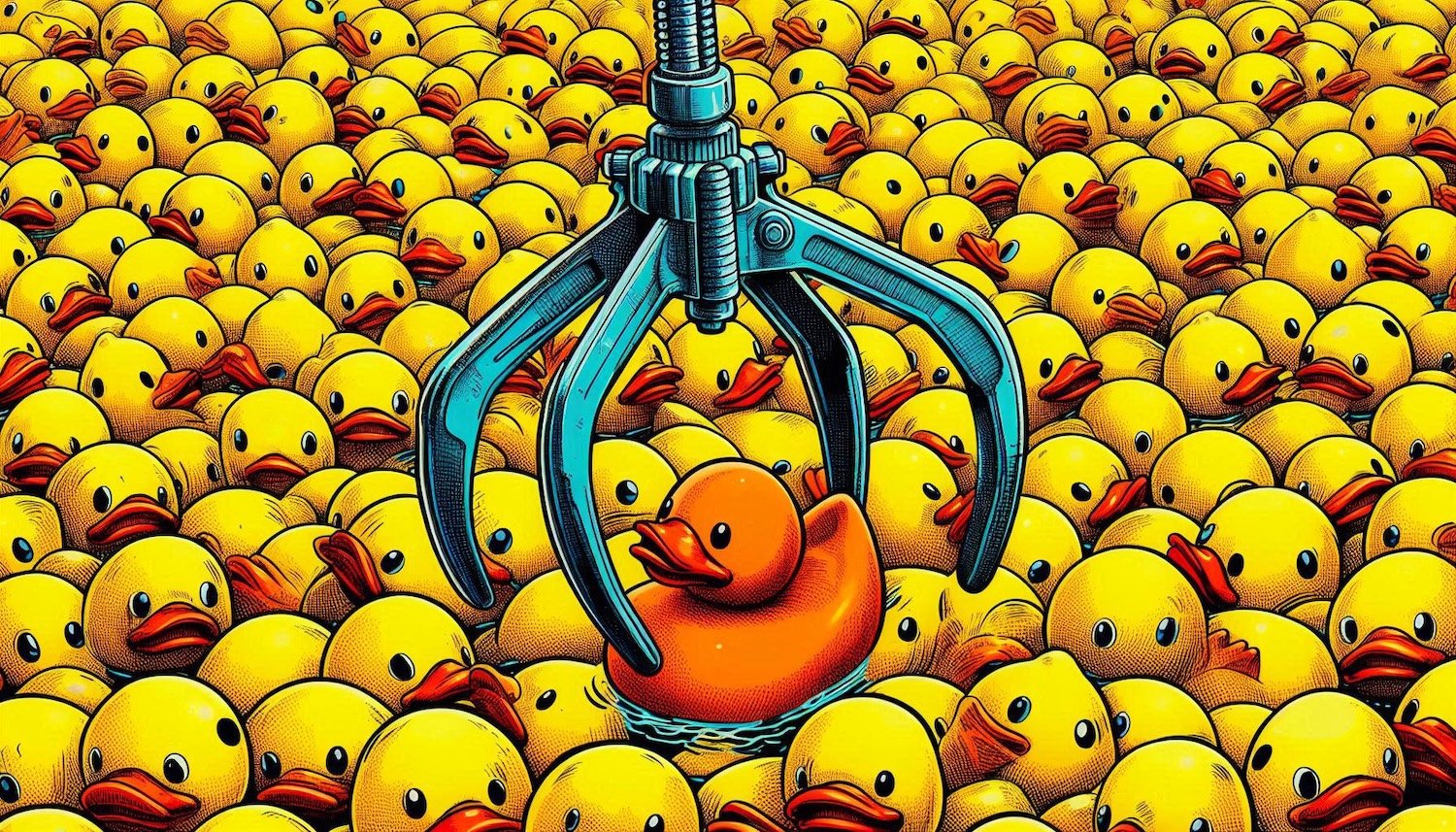We Believe the Future of Brands Is In 3D – Here’s Why

At Hiatus, we believe great design isn’t just about aesthetics; it’s about experiences.
And right now, there’s one innovation that’s reshaping the future of digital design: 3D. From creating immersive environments to rethinking brand storytelling, 3D design is more than a buzzword—it’s a revolution.
Why 3D Is the Next Big Thing in Design
Flat, two-dimensional design has served us well, but it has its limits. It’s static, predictable, and sometimes fails to capture the essence of depth and realism. By contrast, 3D design invites exploration, interaction, and connection. It allows brands to create digital experiences that feel tangible, almost physical, engaging users in ways that 2D simply can’t.
For instance, consider the difference between a static image of a product and an interactive 3D model. A 2D photo might show a sleek new shoe, but a 3D rendering lets users zoom in, rotate the view, and inspect every detail. It’s no longer just a product—it’s an experience.
How 3D Aligns with Emerging Technologies
3D design is the backbone of emerging technologies like augmented reality (AR) and virtual reality (VR). These innovations are no longer futuristic; they’re here, and they’re growing fast thanks for affordable headsets.
Retailers are using AR to let customers visualise products in their own spaces—think furniture, home decor, or even clothing. Meanwhile, VR is transforming everything from online shopping to virtual events. Both rely on high-quality 3D assets to deliver their immersive magic.
For brands, this means one thing: the ability to offer richer, more personalised experiences. Imagine letting your customers virtually “walk through” a new property, try on a pair of sunglasses, or interact with your product in real-time. That’s the kind of storytelling that turns casual viewers into loyal advocates.

3D in Branding and Storytelling
Beyond products and retail, 3D is reshaping branding. Logos and visuals are no longer static; they’re dynamic, responsive, and interactive. A 3D logo that morphs and evolves with user interaction creates intrigue and leaves a lasting impression.
And it’s not just about being flashy. 3D adds layers of depth to a brand’s narrative. It allows companies to show—not just tell—what they stand for. Whether it’s an animated intro on a website or a visually rich 3D explainer video, these elements engage users on an emotional level.
Breaking Down Barriers to Entry
One of the most exciting aspects of 3D is how accessible it’s becoming. What was once exclusive to big-budget campaigns and blockbuster games is now achievable for smaller brands and projects. Advances in software and hardware have democratised 3D design, making it easier for designers and developers to create stunning, interactive experiences.
At Hiatus, we see this as an opportunity for everyone. Whether you’re a start-up looking to stand out or an established business ready to elevate your digital presence, 3D is the key to staying ahead in a crowded marketplace.
Why Now Is the Time to Embrace 3D
The world of digital design is evolving rapidly, and 3D isn’t just a trend—it’s the future. It’s about more than looking good; it’s about staying relevant, competitive, and memorable. As audiences become more accustomed to immersive experiences, 3D design will become the standard for capturing attention and building loyalty.
At Hiatus, we’re ready to lead the charge. We see 3D not just as a tool, but as a mindset—a way to create work that inspires, engages, and pushes boundaries.
You might also like:
It is not just about loud colours or shouty campaigns. Brand excitement is the emotional charge created when three things line up: a clear point of view, a distinctive visual and verbal identity, and experiences that actually live up to the promise.
So how do you know if your brand is genuinely exciting, rather than just busy and noisy?
Most brands claim they want to stand out. Few actually do.
Somewhere between committee feedback, brand guidelines, and “what competitors are doing”, bold ideas get watered down until they’re safe, familiar, and forgettable.
But the truth is, great brands don’t win by staying in their lane. They win by swimming outside it.
In today's dynamic marketplace, the most resilient companies continually seek innovative strategies to expand their reach and enhance their brand portfolio.
One such strategy we often recommend in our marketing audits, is the creation of satellite brands. But what exactly is a satellite brand, and how can it benefit your parent company?
If you’ve not heard of a satellite brand, it’s an extension or offshoot of a larger, more established parent brand. While it operates with a degree of autonomy, it remains closely associated with the main brand, benefiting from its resources, reputation, and market presence.
For most companies, the first signs of growth and future sales aren’t invoices or purchase orders, they’re small changes in awareness and engagement.
These signals are easy to overlook if you’re only focused on closing sales, but they’re often the first proof that your message is landing and that your target audience is taking notice. This is where the law of least mental effort really comes into play.
It usually starts with best practice overload. Brands look to market leaders for inspiration, and before long, everyone is borrowing from the same style guides, stock photo libraries, and brand templates.
There’s a name for this silent killer of innovation, the “sea of same.”
If you’ve not heard of it before, mindshare is the level of awareness, salience, and mental availability a brand occupies in the minds of its target audience.
It's not just about being known, it’s about being remembered first, associated with relevance, trust, and emotional resonance.
In the digital noise of the 21st century, the brands that stand out aren’t always the loudest, they’re the ones that feel right. This is ‘vibe marketing’: a subtle but powerful approach that focuses less on selling features and more on creating a feeling.
In today’s overcrowded digital landscape, standing out isn’t enough. The real goal is to stay ahead, even when imitators try to follow. This is where the idea of a brand moat comes in.
A common trap in copywriting , especially in tech, design, and specialist industries, is when we know a subject deeply, forget what it was like not to know. We assume readers understand the acronyms, the context, the systems… when in fact, we’ve left them behind at the first paragraph.
The defence industry is one of the most sceptical, mission-critical markets in the world for good reasons.
In this space, your product (or service) is only part of the equation. What matters is how you show up, and whether the people you’re trying to serve believe in what you’re building.
Brand Excitement.
It’s not just about recognition or loyalty. It’s about buzz, emotion, movement.
And while it can feel intangible, it can be measured, if you know what to look for.
Instead of simply addressing surface-level symptoms (like low traffic or poor conversion), Root Cause Analysis is a structured approach used to identify the true source of a problem, that helps you dig deeper to understand why the issue is happening in the first place.
When designing information transfer to drive sales conversions (bottom of the funnel) or boost brand awareness (top of the funnel), many businesses make a critical mistake, treating their website like an online pitch deck.
While both serve to communicate your brand’s value and the unique problems your product / service solves, they operate in fundamentally different ways.
‘Organisation antibodies’ are the people, processes, and cultural norms within an organisation designed to protect it from outside threats.
But by resisting disruption and clinging to the status quo, they can also slow vital change that vital for an organisation’s survival and throttle the diffusion of innovation that’s crucial for thriving.
How can leaders recognise these internal barriers?
In today’s digital landscape, brands are no longer just competing for visibility—they’re competing for your trust.
At Hiatus, we believe great design isn’t just about aesthetics; it’s about experiences.
And right now, there’s one innovation that’s reshaping the future of digital design: 3D. From creating immersive environments to rethinking brand storytelling, 3D design is more than a buzzword—it’s a revolution.
A single bad experience can put customers interacting with our brand again, let alone buying from us.
Whether we like to admit it or not, Customer Experience Design (CXD) is a key driver in organisational success.
But how can your business leverage CXD to create a ‘blue ocean’ in a crowded market and boost retention?
Rebranding can feel like an exhilarating leap forward for a company.
However, before diving into the creative aspects of designing a logo, selecting a colour palette, or drafting new slogans, it’s vital to take a comprehensive look “under the ‘hood” of your brand.
So, you’ve decided it’s time to change and enter new markets?
Great! But what happens when a competitor comes along (also seeking new markets) and knocks your stable market position away from you?
A growth engine is a system or process that a business or organisation uses to drive sustainable, scalable growth over time. It is the combination of all the strategies, tactics, and initiatives that a business uses to attract, retain, and monetise customers, and ultimately drive revenue and profitability. This how we make sense of it:
In today’s saturated market, businesses often face the challenge of standing out while building trust and loyalty among customers.
One essential concept that significantly contributes to a brand's success is brand congruence.
But what exactly does it mean, and why is it so pivotal for businesses?
Curiosity marketing is a dynamic strategy that taps into innate human curiosity to captivate audiences. It goes beyond traditional methods by strategically stimulating curiosity and prompting exploration. One key aspect is reward anticipation, strategically hinting at forthcoming benefits to excite consumers. This anticipation fuels their desire to learn more, making it a potent tool for start-ups seeking to generate interest in their offerings.
It might seem easy to assume that offering more options on your website would cater to a broader audience and increase engagement. However, more choices can actually have a negative effect on sales. This is where the concept of "choice overload" comes into play—a phenomenon that can significantly impact how users interact with your website.
A brand’s ‘surface area’ refers to the extent and variety of touchpoints through which a brand interacts with its audience.
These touchpoints can include everything from social media profiles and websites to physical locations, customer service interactions, and even word-of-mouth referrals.
The larger and more diverse your brand's surface area, the greater the opportunities for your target audience to encounter, recognise, and engage with your brand.
Branding is much more than just a logo or a catchy slogan. It is the essence of your business, encompassing everything from your visual identity to the way you communicate with your customers.
At Haus of Hiatus, we believe that effective branding is the key to building a strong, recognisable, and trustworthy business. This is achieved through the principles of associative learning, the law of least mental effort, and the mere exposure effect.
Early adopters are people who are among the first to try out and adopt a new product or technology. They are often highly interested in innovation and are willing to take risks to try out new things before the general public does. Early adopters can be influential in determining the success or failure of a new product or technology, as they can help to create buzz and generate interest among a wider audience. This is how we like to engage with them best:
Staying ahead of the competition requires a keen understanding of consumer behaviour and market trends.
One of the most effective ways to gain this understanding is by monitoring demand signals. But what exactly are demand signals, and how can businesses detect them?
Establishing trust with your website visitors is more critical than ever these days.
As the risk of working online continues to intensify, users are increasingly cautious about where they spend their time and money. To stand out from the crowd and foster credibility, it's essential to incorporate the most effective "trust signals" into your website.
In this article, we'll explore the top trust signals to prioritise in 2024 to build trust, enhance user experience, and drive conversions.
In today's competitive market landscape, a brand refresh is often the key to staying relevant and resonating with evolving consumer preferences.
However, the success of such an endeavour hinges on more than just a fresh coat of paint; it requires strategic planning, thoughtful execution, and perhaps most importantly, the active involvement of all stakeholders from the outset.
We all know, first impressions are vital for a business.
In the ever-changing landscape of business and sales, understanding the intricacies of consumer perception is paramount to your survival.
This is where the 'Halo Effect' – a psychological phenomenon that can significantly influence how your brand is perceived, really comes into own.
About the Author:
Chris is the founder of Hiatus.Design, a mission-driven branding and website design company that works with clients all over the world.
Over the course of his life, he has travelled to more than 60 countries across six continents, earned two Guinness World Records, completed the legendary Marathon des Sables, summited Mont Blanc and unclimbed peaks in Asia, become a Fellow of the Royal Geographical Society (FRGS), rowed across the Atlantic Ocean and obtained a Masterʼs degree in Business Management (MA).






























